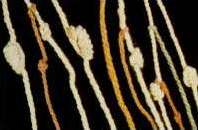 Llaman
hamun tutayaypi punaman / quyllor hina ñawintin /
llantullamanta paqarin, llaman hamun.
Llaman
hamun tutayaypi punaman / quyllor hina ñawintin /
llantullamanta paqarin, llaman hamun.
Viene
La constelación de la Llama / por la noche / por la puna / con
ojos estrellados / nacida de sombras / viene la Llama.
Comes
the constellation of the Llama / through the night /
over the
highlands / with eyes made of stars /
born in shadows / comes the
Llama.
@www.andes.org
Picture:
The dark constellation of the llama and Mayu
(the celestial river).
ANDEAN ASTRONOMY
Here are some Qechua
(the language of the Incas) words related to astronomy:
·
Inti:
Sun, Killa:
Moon, Qoyllor:
Star, Ch'aska:
Venus, Qollqa:
Pleaides. Mayu:
Milky Way
·
Wata:
year, Killa:
month, Tuta:
night, P'unchay:
Day, Chaupy
p'unchai:
Noon, Chaupi
tuta:
Midnight
·
Intiwatana:
Solar Observatory
·
 Quipu:
Database and calculator (like a computer ...). Perhaps it was also a
written system. A quipu is an assemblage of colored cords with knots.
Several scientists have tried to break the quipu code, but there is
still a lot to learn. I think that precious astronomical information
was written on quipus. Who knows ... so much information ... comets,
supernovae, eclipses ...
Quipu:
Database and calculator (like a computer ...). Perhaps it was also a
written system. A quipu is an assemblage of colored cords with knots.
Several scientists have tried to break the quipu code, but there is
still a lot to learn. I think that precious astronomical information
was written on quipus. Who knows ... so much information ... comets,
supernovae, eclipses ...
·
The 3 rules of the Inca society: Ama
Sua, Ama Llula, Ama Kella:
Do not be a thief, liar neither lazy.
HARVARD
STATION IN PERU : Distances in the
Universe & The Classification of the Stars


·
Using plates taken from Arequipa (Peru), Henrietta Leavitt discovered
the luminosity-period relation of Cepheids in the SMC. Later, these
stellar candles were used to measure extragalactic distances in the
Universe, and to develop the Big Bang theory ...
·
and from spectra taken at the Harvard Station in Peru, Annie Cannon
(and others) built the famous Henry Draper (HD) catalogue,
classifying thousands of stellar spectra, and introducing the most
used classification system in astronomy (OBAFGKM).
DEVELOPMENT OF MODERN
ASTRONOMY IN PERU
·
The first Peruvian to earn a degree in astronomy (Univ. La Plata) is
Prof. Astronomer Maria Luisa Aguilar (about 1970).
·
In 1982 M. L. Aguilar founded SPACE
(Seminario Permanente de Astronomia y Ciencias Espaciales) at the
Universidad Nacional Mayor de San Marcos (UNMSM), the oldest
university in the Americas. SPACE is the major organization that
promotes astronomy (research, teaching, popularization) in Peru. The
home page of SPACE is: www.concytec.gob.pe/space
·
In the 90's several Peruvian students went abroad to study astronomy.
The first Peruvian to get a PhD in Astronomy is (as far as I know)
Rafael Carlos. He is currently working at the UNMSM.
·
In the 2000's Prof. Maria Luisa has been working hard to put a
telescope in the highlands of Cuzco. As often as possible, R. Carlos
and students of SPACE-UNMSM, make photometric observations using a
small telescope + CCD camera.
SUPPORT
ASTRONOMY IN PERU: donate a laptop computer (or books)
·
You are very welcome to make a donation. Want to get rid of your
notebook? Our students will really appreciate your contribution.
Please, contact Jorge Melendez (jorge
@ astro . iag . usp .br).
·
Books, Fellowships, Travel Grants, Equipment, Subscription to
journals and magazines, etc., will be greatly appreciated.
·
Some books we would like to receive: Astrophysical
Quantities 4th ed., Astrophysical
Formulae 3rd ed., An
Introduction to Modern Astrophysics (Carroll & Ostlie 1995),
Fundamental
Astronomy 4th ed. (Karttunen 2003), Astrophysical
Techniques 4th ed. (Kitchin 2003), The
Observation and Analyses of Stellar Photospheres 2nd ed. (Gray
1992), Radiative
Processes in Astrophysics (Rybicki 1985), Astrophysical
Concepts 3rd ed. (Harwit 1998), Space
Physics (An Introduction to Plasmas), The
New Solar System (Beatty 1998), Sky
Atlas 2000 2nd ed, Norton's
Star Atlas & Ref. Handbook 20th ed., Observer's
Handbook 2004, Observing
Variable Stars (Good 2003)
|
E-mail: NO_SPAM_jorge AT astro.iag.usp.br
|
Last updated: Nov 8, 2010
|
 Llaman
hamun tutayaypi punaman / quyllor hina ñawintin /
llantullamanta paqarin, llaman hamun.
Llaman
hamun tutayaypi punaman / quyllor hina ñawintin /
llantullamanta paqarin, llaman hamun.
 Quipu:
Database and calculator (like a computer ...). Perhaps it was also a
written system. A quipu is an assemblage of colored cords with knots.
Several scientists have tried to break the quipu code, but there is
still a lot to learn. I think that precious astronomical information
was written on quipus. Who knows ... so much information ... comets,
supernovae, eclipses ...
Quipu:
Database and calculator (like a computer ...). Perhaps it was also a
written system. A quipu is an assemblage of colored cords with knots.
Several scientists have tried to break the quipu code, but there is
still a lot to learn. I think that precious astronomical information
was written on quipus. Who knows ... so much information ... comets,
supernovae, eclipses ...